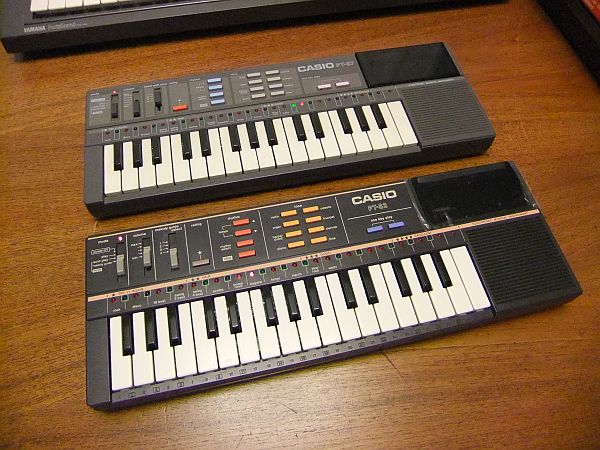<--
Back to the Electronic Home Keyboards page

The PT-82 was available in a choice of colours; my example is dark grey, but it was also available in white and red. I have never seen a PT-87 in any colour other than grey, so I don't know if the colour options were available for this model.
These are very basic, monophonic, semi-toy keyboards. A choice of 12 rhythms and 8 voices is available. When playing the keyboard manually, only rhythm (consisting of 'blips' and noise pulses) is available - there is no chord accompaniment. Despite this, the ROM-Pack music is still rendered quite nicely, complete with chords and two-voice polyphony.
In common with most ROM-Pack keyboards, the four-level "Melody Guide" training feature is available. This teaches you how to play the ROM-Pack tunes by lighting LEDs above each key, and blinking the light above the key that is to be played next. White notes have red LEDs, while black notes are indicated by green LEDs. Additionally, the PT-82 and PT-87 feature a "Rating" feature, which scores your performance, based on how accurately you played the tune last. This uses the LEDs above the keys as a kind of graph - the further right the LED that lights, the higher your score for that performance. Ratings of "Try it again", "Fair", "Good" and "Excellent" are marked on the keyboard, and each rating class is associated with a jingle that plays after the rating is displayed.
The PT-82 retailed for £59.00 in a 1986 Argos catalogue.
Of all the keyboards I own, this is among my favourites. The simple square-wave-based voices with minimal filtering, combined with the simplistic rhythm and accompaniment, perfectly encapsulate everything I love about these old 1980s keyboards. The built-in speaker lets it down a bit, but through external amplification it sounds just gorgeous.

Description
The PT-82 and PT-87 are almost identical. Apart from the obvious colour differences, the PT-87 tends to lack an output jack, while the PT-82 typically includes one, although there are versions of both models both with and without the output jack. (The EP-20 Muppets keyboard is also essentially the same as the PT-82 and PT-87, but contains a single embedded ROM with 4 songs from The Muppets and does not have a ROM Pack compartment.)The PT-82 was available in a choice of colours; my example is dark grey, but it was also available in white and red. I have never seen a PT-87 in any colour other than grey, so I don't know if the colour options were available for this model.
These are very basic, monophonic, semi-toy keyboards. A choice of 12 rhythms and 8 voices is available. When playing the keyboard manually, only rhythm (consisting of 'blips' and noise pulses) is available - there is no chord accompaniment. Despite this, the ROM-Pack music is still rendered quite nicely, complete with chords and two-voice polyphony.
In common with most ROM-Pack keyboards, the four-level "Melody Guide" training feature is available. This teaches you how to play the ROM-Pack tunes by lighting LEDs above each key, and blinking the light above the key that is to be played next. White notes have red LEDs, while black notes are indicated by green LEDs. Additionally, the PT-82 and PT-87 feature a "Rating" feature, which scores your performance, based on how accurately you played the tune last. This uses the LEDs above the keys as a kind of graph - the further right the LED that lights, the higher your score for that performance. Ratings of "Try it again", "Fair", "Good" and "Excellent" are marked on the keyboard, and each rating class is associated with a jingle that plays after the rating is displayed.
The PT-82 retailed for £59.00 in a 1986 Argos catalogue.
Of all the keyboards I own, this is among my favourites. The simple square-wave-based voices with minimal filtering, combined with the simplistic rhythm and accompaniment, perfectly encapsulate everything I love about these old 1980s keyboards. The built-in speaker lets it down a bit, but through external amplification it sounds just gorgeous.
Audio Samples
As mentioned above, the PT-87 does not have an audio output socket, so it is difficult to make good recordings from it. These samples are therefore from the PT-82, but the two models sound identical.- Unterlanders Heimweh (from RO-551) - 1m05s, MP3, 2MB
- Greensleeves (from RO-551) - 1m22s, MP3, 2.5MB
- Die Lorelei (from RO-551) - 2m24s, MP3, 4.4MB
- Old Folks at Home (from RO-551) - 2m11s, MP3. 4MB
- Switch-On Jingle (the sound the keyboard makes when first switched on) - 0m02s, MP3, 46KB
- Excellent Rating - 0m16s, MP3, 530KB
- Good Rating - 0m11s, MP3, 372KB
- Fair Rating - 0m11s, MP3, 356KB
- Try Again - 0m06s, MP3, 190KB
Instruction Manuals
- PT-82 Operation Manual (English pages only) - PDF, 960KB
- PT-87 Operation Manual (English pages only) - PDF, 896KB